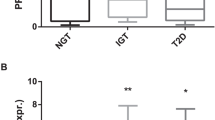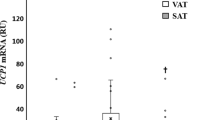Abstract
Objective:
The role of glucocorticoids production in adipose tissue in the development of metabolic disorders in humans has not been fully characterized. We investigated whether in obese subjects, 11β-hydroxysteroid dehydrogenase type 1 (11β-HSD1) expression in subcutaneous (SAT) and visceral (VAT) adipose tissue is associated with the occurrence of metabolic disorders and the expression of adiponectin and tumor necrosis factor α (TNFα) and two glucocorticoid-regulated adipokines able to influence the metabolic control.
Design and subjects:
Sixty-two obese patients were enrolled in the study. SAT and VAT samples were obtained from 13 patients undergoing bariatric surgery (body mass index (BMI) 39.1±5.3 kg/m2). SAT samples were obtained from 49 patients who underwent periumbilical biopsy (BMI 36.9±5.1 kg/m2).
Measurements:
Oral glucose tolerance tests in subjects without known diabetes. Circulating glucose, lipid, insulin, adiponectin, TNFα and urinary-free cortisol levels. Real-time PCR to quantify mRNA levels of 11β-HSD1, hexose-6-phosphate dehydrogenase (H6PDH), adiponectin and TNFα. Western blot analysis to evaluate 11β-HSD1 protein expression.
Results:
In the majority of the obese subjects, VAT expresses more 11β-HSD1 than SAT. VAT 11β-HSD1 expression was not associated with metabolic disorders. SAT 11β-HSD1 mRNA levels were higher in subjects with than in those without metabolic syndrome (P<0.05) and in patients with type 2 diabetes compared to patients with impaired or normal glucose tolerance (P<0.0001). SAT 11β-HSD1 expression was independently related to fasting glucose (P<0.0001) and urinary-free cortisol levels (P<0.01), and increased expression of 11β-HSD1 was associated with increased adiponectin and TNFα expression and decreased serum adiponectin levels (all P’s <0.05).
Conclusions:
In obese subjects, increased 11β-HSD1 expression in SAT, but not in VAT, is associated with the worsening of metabolic conditions. We hypothesize that higher glucocorticoid production in adipose tissue would favor the development of metabolic disorders through a decrease in adiponectin release.
This is a preview of subscription content, access via your institution
Access options
Subscribe to this journal
Receive 12 print issues and online access
$259.00 per year
only $21.58 per issue
Buy this article
- Purchase on Springer Link
- Instant access to full article PDF
Prices may be subject to local taxes which are calculated during checkout


Similar content being viewed by others
References
Wang M . The role of glucocorticoid action in the pathophysiology of the metabolic syndrome. Nutr Metab (London) 2005; 2: 3.
Bujalska IJ, Kumar S, Stewart PM . Does central obesity reflect ‘Cushing's disease of the omentum’? Lancet 1997; 349: 1210–1213.
Masuzaki H, Pateson J, Shinyama H, Morton NM, Mullins JJ, Seckl JR et al. A transgenic model of visceral obesity and the metabolic syndrome. Science 2001; 294: 2166–2170.
Kotelvtsev Y, Holmes MC, Burchell A, Houston PM, Schmoll D, Jamieson P et al. 11β-hydroxysteroid dehydrogenase type 1 knockout mice show attenuated glucocorticoid-inducible responses and resist hyperglycemia on obesity or stress. Proc Natl Acad Sci USA 1997; 94: 14924–14929.
Morton NM, Paterson JM, Masuzaki H, Holmes MC, Staels B, Fievet C et al. Novel adipose tissue-mediated resistance to diet-induced visceral obesity in 11 β-hydroxysteroid dehydrogenase type 1 deficient mice. Diabetes 2004; 53: 931–938.
Thieringer R, Hermanowski-Vosatka A . Inhibition of 11 β-HSD1 as a novel treatment for the metabolic syndrome: do glucocorticoids play a role? Expert Rev Cardiovasc Ther 2005; 3: 911–924.
Andrews RC, Rooyackers O, Walker BR . Effects of the 11β-hydroxysteroid dehydrogenase inhibitor carbenoxolone on insulin sensitivity in men with type 2 diabetes. J Clin Endocrinol Metab 2003; 88: 285–291.
Whorwood CB, Donovan SJ, Flanagan D, Phillips DI, Byrne CD . Increased glucocorticoid receptor expression in human skeletal muscle cells may contribute to the pathogenesis of the metabolic syndrome. Diabetes 2002; 51: 1066–1075.
Abdallah BM, Beck-Nielsen H, Gaster M . Increased expression of 11 β-hydroxysteroid dehydrogenase type 1 in type 2 diabetic myotubes. Eur J Clin Invest 2005; 35: 627–634.
Paulmyer-Lacroix O, Boullu S, Oliver C, Alessi MC, Grino M . Expression of the mRNA coding for 11 β-hydroxysteroid dehydrogenase type 1 in adipose tissue from obese patients: an in situ hybridization study. J Clin Endocrinol Metab 2002; 87: 2701–2705.
Lindsay RS, Wake DJ, Nair S, Bunt J, Livingstone DEW, Permana PA et al. Subcutaneous adipose 11 β-hydroxysteroid dehydrogenase type 1 activity and messenger ribonucleic acid levels are associated with adiposity and insulinemia and Pima Indians and Caucasians. J Clin Endocrinol Metab 2003; 88: 2738–2744.
Kannisto K, Pietilainen KH, Ehrenborg E, Rissanen A, Kaprio J, Hamsten A et al. Overexpression of 11beta-hydroxysteroid dehydrogenase-1 in adipose tissue is associated with acquired obesity and features of insulin resistance: studies in young adult monozygotic twins. J Clin Endocrinol Metab 2004; 89: 4414–4421.
Koistinen HA, Forsgren M, Wallberg-Henriksson H, Zierath JR . Insulin action on expression of novel adipose genes in healthy and type 2 diabetic subjects. Obes Res 2004; 12: 25–31.
Andrews RC, Herlihy O, Livingstone DE, Andrew R, Walker BR . Abnormal cortisol metabolism and tissue sensitivity to cortisol in patients with glucose intolerance. J Clin Endocrinol Metab 2002; 87: 5587–5593.
Bronnegard M, Arner P, Hellstrom L, Akner G, Gustafsson JA . Glucocorticoid receptor messenger ribonucleic acid in different regions of human adipose tissue. Endocrinology 1990; 127: 1689–1696.
Bujalska IJ, Quinkler M, Tomlinson JW, Montague CT, Smith DM, Stewart PM . Expression profiling of 11(beta)-hydroxysteroid dehydrogenase type-1 and glucocorticoid-target genes in subcutaneous and omental human preadipocytes. J Mol Endocrinol 2006; 37: 327–340.
Tomlinson JW, Sinha B, Bujalska I, Hewison M, Stewart PM . Expression of 11 β-hydroxysteroid dehydrogenase type 1 in adipose tissue is not increased in human obesity. J Clin Endocrinol Metab 2002; 87: 5630–5635.
Goedecke JH, Wake DJ, Levitt NS, Lambert EV, Collins MR, Morton NM et al. Glucocorticoid metabolism within superficial subcutaneous rather than visceral adipose tissue is associated with features of the metabolic syndrome in South African women. Clin Endocrinol 2006; 65: 81–87.
Desbriere R, Vuaroqueaux V, Achard V, Boullu-Ciocca S, Labuhn M, Dutour A et al. 11beta-hydroxysteroid dehydrogenase type 1 mRNA is increased in both visceral and subcutaneous adipose tissue of obese patients. Obesity 2006; 14: 794–798.
Grundy SM, Cleeman JI, Daniels SR, Donato KA, Eckel RH, Franklin BA et al. American Heart Association; National Heart, Lung, and Blood Institute. Diagnosis and management of the metabolic syndrome: an American Heart Association/National Heart, Lung, and Blood Institute Scientific Statement. Circulation 2005; 112: 2735–2752.
Hewitt KN, Walker EA, Stewart PM . Minireview: hexose-6-phosphate dehydrogenase and redox control of 11(beta)-hydroxysteroid dehydrogenase type 1 activity. Endocrinology 2005; 146: 2539–2543.
Havel RJ, Kane JP, Balasse EO, Segel N, Basso LV . Splanchnic metabolism of free fatty acids and production of triglycerides of very low density lipoproteins in normotriglyceridemic and hypertriglyceridemic humans. J Clin Invest 1970; 49: 2017–2035.
Wang Y, Rimm EB, Stampfer MJ, Willett WC, Hu FB . Comparison of abdominal adiposity and overall obesity in predicting risk of type 2 diabetes among men. Am J Clin Nutr 2005; 81: 555–563.
Andrew R, Westerbacka J, Wahren J, Yki-Jarvinen H, Walker BR . The contribution of visceral adipose tissue to splanchnic cortisol production in healthy humans. Diabetes 2005; 54: 1364–1370.
Berger J, Tanen M, Elbrecht A, Hermanowski-Vosatka A, Moller DE, Wright SD et al. Peroxisome proliferator-activated receptor-gamma ligands inhibit adipocyte 11beta -hydroxysteroid dehydrogenase type 1 expression and activity. J Biol Chem 2001; 276: 12629–12635.
Engeli S, Bohnke J, Feldpausch M, Gorzelniak K, Heintze U, Janke J et al. Regulation of 11 β-HSD genes in human adipose tissue: influence of central obesity and weight loss. Obes Res 2004; 12: 9–17.
Wake DJ, Rask E, Livingstone DE, Soderberg S, Olsson T, Walker BR . Local and systemic impact of transcriptional up-regulation of 11beta-hydroxysteroid dehydrogenase type 1 in adipose tissue in human obesity. J Clin Endocrinol Metab 2003; 88: 3983–3988.
Tomlinson JW, Stewart PM . Cushing's disease of the omentum’ – fact or fiction? J Endocrinol Invest 2004; 27: 171–174.
Draper N, Stewart PM . 11 β-hydroxysteroid dehydrogenase and the pre-receptor regulation of corticosteroid hormone action. J Endocrinol 2005; 186: 251–271.
Valsamakis G, Anwar A, Tomlinson JW, Shackleton CHL, McTernan PG, Chetty R et al. 11 β-hydroxysteroid dehydrogenase type 1 activity in lean and obese males with type 2 diabetes mellitus. J Clin Endocrinol Metab 2004; 89: 4755–4761.
Lavery GG, Walker EA, Draper N, Jeyasuria P, Marcos J, Shackleton CHL et al. Hexose-6-phosphate dehydrogenase knock-out mice lack 11β- hydroxysteroid dehydrogenase type 1-mediated glucocorticoid generation. J Biol Chem 2006; 281: 6546–6551.
Mariniello B, Ronconi V, Rilli S, Bernante P, Boscaro M, Mantero F et al. Adipose tissue 11beta-hydroxysteroid dehydrogenase type 1 expression in obesity and Cushing's syndrome. Eur J Endocrinol 2006; 155: 435–441.
Morton NM, Paterson JM, Masuzaki H, Holmes MC, Staels B, Fievet C et al. Novel adipose tissue-mediated resistance to diet-induced visceral obesity in 11 beta-hydroxysteroid dehydrogenase type 1-deficient mice. Diabetes 2004; 53: 931–938.
Degawa Yamauchi M, Moss KA, Bovekerk JE, Shankar SS, Morrison CL, Lelliott CJ et al. Regulation of adiponectin expression in human adipocytes: effects of adiposity, glucocorticoids and tumor necrosis factor α. Obes Res 2005; 13: 662–669.
Fallo F, Scarda A, Sonino N, Paoletta A, Boscaro M, Pagano C et al. Effect of glucocorticoids on adiponectin: a study in healthy subjects and in Cushing's syndrome. Eur J Endocrinol 2004; 150: 339–344.
Wang B, Trayhurn P . Acute and prolonged effects of TNF-alpha on the expression and secretion of inflammation-related adipokines by human adipocytes differentiated in culture. Pflugers Arch 2006; 452: 418–427.
Friedberg M, Zoumakis E, Hiroi N, Bader T, Chrousos GP, Hochberg Z . Modulation of 11 β-hydroxysteroid dehydrogenase type 1 in mature human subcutaneous adipocytes by hypothalamic messengers. J Clin Endocrinol Metab 2003; 88: 385–393.
Tomlinson JW, Moore J, Cooper MS, Bujalska I, Shahmanesh M, Burt C et al. Regulation and expression of 11 β-hydroxysteroid dehydrogenase type 1 in adipose tissue: tissue specific induction by cytokines. Endocrinol 2001; 142: 1982–1989.
Ouchi N, Kihara S, Funahashi T, Matsuzawa Y, Walsh K . Obesity, adiponectin and vascular inflammatory disease. Curr Opin Lipidol 2003; 14: 561–566.
Acknowledgements
This work was supported by the Grant 195-2003 from the Italian Ministry of Health.
Author information
Authors and Affiliations
Corresponding author
Rights and permissions
About this article
Cite this article
Alberti, L., Girola, A., Gilardini, L. et al. Type 2 diabetes and metabolic syndrome are associated with increased expression of 11β-hydroxysteroid dehydrogenase 1 in obese subjects. Int J Obes 31, 1826–1831 (2007). https://doi.org/10.1038/sj.ijo.0803677
Received:
Revised:
Accepted:
Published:
Issue Date:
DOI: https://doi.org/10.1038/sj.ijo.0803677
Keywords
This article is cited by
-
In vitro models to study insulin and glucocorticoids modulation of trimethyltin (TMT)-induced neuroinflammation and neurodegeneration, and in vivo validation in db/db mice
Archives of Toxicology (2019)
-
Enhanced hexose-6-phosphate dehydrogenase expression in adipose tissue may contribute to diet-induced visceral adiposity
International Journal of Obesity (2018)
-
Association of HSD11B1 polymorphic variants and adipose tissue gene expression with metabolic syndrome, obesity and type 2 diabetes mellitus: a systematic review
Diabetology & Metabolic Syndrome (2015)
-
Overexpression of 11β-Hydroxysteroid Dehydrogenase Type 1 in Hepatic and Visceral Adipose Tissue is Associated with Metabolic Disorders in Morbidly Obese Patients
Obesity Surgery (2010)
-
Diabetes mellitus: new challenges and innovative therapies
EPMA Journal (2010)



